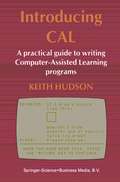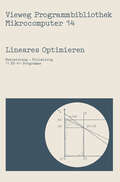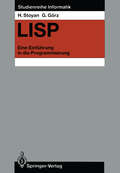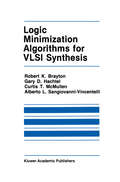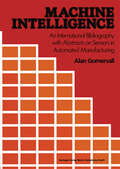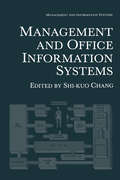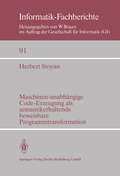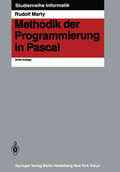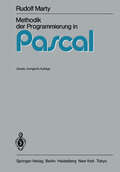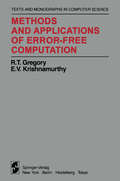- Table View
- List View
Informatik als Herausforderung an Schule und Ausbildung: GI-Fachtagung, Berlin, 8.–10. Oktober 1984 (Informatik-Fachberichte #90)
by W. Arlt K. HaefnerInformation Technology and the Computer Network (NATO ASI Subseries F: #6)
by K. G. Beauchamp1.1 Scope This paper deals with the following subjects: 1. Introduction 2. Feasibility study definition in IT 3. Forming a feasibility study team 4. The feasibility study work 5. The feasibility study report 6. Discussion 1.2 Information Technology (IT) Information was defined as anything sensed by at least one of the human senses and that may change the level of his knowledge. The information may be true or false, sent by premeditation or generated by coincidence, needed by the interceptor or intended to create new needs. The creation of the information may be very costly or free of charge. The information may be an essential need or just a luxury. Each information may be a one shot nature, eg., announcing a marriage, or a constant update need one, eg., news. Information technology as defined herein means all the types of systems needed to deal wi.th the information, transfer it to any place, store it, adapt it, etc. Information technology is usually bused on Telecommunications. Telecommunications means a large variety of possibilities. Usually, the IT's are based on the creation, updating, processing and transmission of information. The information itself is usually alphanumeric and graphic. Gradually, there is a tendency to step over to what is seen as more natural information, audio and visual.
Interactive Graphics in CAD
by Y. Gardan LucasIn a society in which the use of information technology is becoming commonplace it is natural that pictures and images produced by elec tronic means should be increasing in importance as a means of com munication. Computer graphics have only recently come to the atten tion of the general public, mainly through animated drawings, advertise ments and video games. The quality of the pictures is often such that, unless informed of the fact, people are unaware that they are created with the help of computers. Some simulations, those developed in con nection with the space shuttle for example, represent a great and rapid progress. In industry, computer graphic techniques are used not only for the presentation of business data, but also in design and manufacture processes. Such computer-assisted systems are collectively represented by the acronym CAX. In CAD/CAM (computer-assisted design/manufacture), interactive graphic techniques have attained considerable importance. In CAD/CAM systems a dialogue can be established between the user and the machine using a variety of easy to operate communication devices. Due to the recent developments in hardware and software (for modelling, visual display, etc), a designer is now able to make decisions based on the information presented (plans, perspective drawings, graphics, etc) with the help of interactive, graphic techniques. These constitute the most visible and perhaps most spectacular aspect of CAD/CAM systems.
International Calibration Study of Traffic Conflict Techniques (NATO ASI Subseries F: #5)
by E. AsmussenThe concept of traffic conflict was initiated in the Uni ted States in the 60s and raised a lot of interest in many countries : it was an opening towards the develop ment of a new tool for safety evaluation and the diagnosis of local safety pro blems. The need for such a tool was great, because of the many situations where accident data was either scarce, unsatisfactory or unavailable. Development of Traffic Conflict Techniques (TCT) started simultaneously in the 70s in several European count ries and new studies were also undertaken in the Uni ted States, Canada and Israel. The need for international cooperation was rapidly feIt, in order to exchange data, compare definitions and check progresses. An Association for International Cooperation on Traffic Conflict Techniques (ICTCT) was therefore created, grouping researchers and safety administrators, with the aim of promoting and organising exchange of information and common practical work. Three Traffic Conflict Techniques Workshops were organised, in Oslo (1977), Paris (1979) and Leidschendam (1982). A small scale international experiment of calibra tion of TCTs was also carried out in Rouen, France, in 1979, and five teams took part in it from France, Germany, Sweden, the United Kingdom and the United States; results of this first experiment were used as a basis for the present enterprise. To be acknowledged as a safety measuring tool, traffic conflict techniques had to be validated in relation to traditional safety indicators such as injury-accidents.
Introducing CAL: A practical guide to writing Computer-Assisted Learning programs
by Keith HudsonIt is often the case - perhaps more often than not - that new ideas arrive long before there is the me ans to clothe and deli ver them. We can think ofLeonardo da Vinci's drawings of helicopters and submarines among many other examples. Computer-Assisted Learning (CAL) is an example of an idea which has had a particularly long gestation. As I will illustrate early in the book, the principles of CAL were really first discovered by Socrates. As a formal method of teaching, the Socratic method disappeared for over two millennia until the 1950s. It was then revived in the form ofProgrammed Learning (PL) which resulted from the researches ofB. F. Skinner at Harvard University. Even then, PL was premature. In the 1950s and 60s, methods were devised, such as teaching machines and various sorts ofPL text books, and there was a mushrooming of PL publishing at that time. For a complex of reason- economic, logistical and technical-PL also largely disappeared from the mid- 60s, although it continued in a few specialized areas ofteaching and industrial training. However, during the same period, PL quietly transformed itselfinto CAL. But the computerized form was not capable of mass dissemination until recently hecause personal microcomputers did not have sufficient internal memory sizes. That situation has now changed very dramatically and 128K microcomputers are becoming cheap and widely available. Cheap memory chips of256K and 1024K cannot be far away, either.
Koordination von Informationen: Die Bedeutung von Informations- und Kommunikationstechnoligien in privaten und öffentlichen Verwaltungen. IX. Verwaltungsseminar, Konstanz, 5.–7. Mai 1983 (Informatik-Fachberichte #81)
by R. KuhlenLineares Optimieren: Maximierung — Minimierung (Vieweg-Programmbibliothek Mikrocomputer #14)
by Herbert MaiDieser Band der Vieweg Programmbibliothek beschäftigt sich mit der Anwendung unter schiedlicher Varianten des Simplexverfahrens bei der Lösung linearer Ungleichungs· und/ oder Gleichungssysteme, wie sie bei der mathematischen Behandlung von Planungsvorbe· reitungen und Entscheidungsfindungen eingesetzt werden. Durch die Einbeziehung von Taschencomputern sollen auch umfangreichere Aufgaben zuverlässig rechenbar gemacht werden. Der Band wendet sich in erster Linie an Schüler und Studenten, für deren Bedürfnisse die Kapazität leistungsstarker, programmierbarer Taschenrechner ausreicht. Die hier vorge stellten Programme sind für den Hewlett-Packard HP-41 in der Ausstattung mit Ouad Modul und Magnetkartenleser entwickelt worden. Um dem Leser das Nachvollziehen der Programme zu erleichtern, sind diese so gehalten, daß die Veränderungen von einem Programm zum anderen möglichst gering sind. Es soll damit auch ein Weg aufgezeigt werden, wie man von zunächst recht einfachen Programmen zu aufwendigeren Lösungsverfahren gelangt. Für Leser, die Besitzer anderer Taschenrech ner oder Kleincomputer sind, werden die Beschreibungen der Rechenverfahren so gewählt, daß auch sie leicht eigene Programme zu den hier vorgestellten Verfahren schreiben können. Zudem soll dieser Band eine Anregung darstellen, die Programme für die eigenen Bedürf· nisse zu variieren und auch andere Verfahren der linearen Optimierung zu programmieren. Der Verfasser bietet mit der programmierten Lösung zu einfachen Anwendungen der linearen Programmierung einen interessanten Einstieg in dieses zunehmend wichtiger werdende Fachgebiet. Es wird besonderer Wert auf das Verständnis des mathematischen Hintergrundes gelegt. Die Herausgeber Inhaltsverzeichnis 1 Einleitung .............................................. .
Logic Minimization Algorithms for VLSI Synthesis (The Springer International Series in Engineering and Computer Science #2)
by Robert K. Brayton Gary D. Hachtel C. McMullen Alberto L. Sangiovanni-VincentelliThe roots of the project which culminates with the writing of this book can be traced to the work on logic synthesis started in 1979 at the IBM Watson Research Center and at University of California, Berkeley. During the preliminary phases of these projects, the impor tance of logic minimization for the synthesis of area and performance effective circuits clearly emerged. In 1980, Richard Newton stirred our interest by pointing out new heuristic algorithms for two-level logic minimization and the potential for improving upon existing approaches. In the summer of 1981, the authors organized and participated in a seminar on logic manipulation at IBM Research. One of the goals of the seminar was to study the literature on logic minimization and to look at heuristic algorithms from a fundamental and comparative point of view. The fruits of this investigation were surprisingly abundant: it was apparent from an initial implementation of recursive logic minimiza tion (ESPRESSO-I) that, if we merged our new results into a two-level minimization program, an important step forward in automatic logic synthesis could result. ESPRESSO-II was born and an APL implemen tation was created in the summer of 1982. The results of preliminary tests on a fairly large set of industrial examples were good enough to justify the publication of our algorithms. It is hoped that the strength and speed of our minimizer warrant its Italian name, which denotes both express delivery and a specially-brewed black coffee.
Machine Intelligence: An International Bibliography with Abstracts of Sensors in Automated Manufacturing
by A. GomersallIn 1981 Robotics Bibliography was published containing over 1,800 references on industrial robot research and development, culled from the scientific literature over the previous 12 years. It was felt that sensors for use with industrial robots merited a section and accordingly just over 200 papers were included. It is a sign of the increased research into sensors in production engineering that this bibliography on both the contact and non-contact forms has appeared less than three years after that first comprehensive collection of references appeared. In a reviell''; in 1975 Professor Warnecke of IPA, Stuttgart drew attention to the lack of sensors for touch and vision. Since then research workers in various companies, universities and national laboratories in the USA, the UK, Italy, Germany and Japan have concentrated on improving sensor capabilities, particularly utilising vision, artificial intelligence and pattern recognition principles. As a result many research projects are on the brink of commercial exploitation and development. This biblio graphy brings together the documentation on that research and development, highlighting the advances made in vision systems, but not neglecting the development of tactile sensors of various types. No bibliography can ever be comprehensive, but significant contributions from research workers and production engineers from the major industrialised countries over the last 12 years have been included.
Management and Office Information Systems
by SShi-Kuo ChangDecision making is a very complex phenomenon. Modern decision makers must deal with very complex problems which are constantly changing and often ill structured, making modeling and analysis difficult. In order to provide support for the decision makers, computer-based information systems are designed to collect, store, process, and transport information. Recent advances in computer technol ogy, data communications, database systems, office automation, and knowledge engineering have made possible the design of very sophisticated information sys tems. However, rapid technological advances also create many problems, not the least of which is the lack of integration among the various disciplines in infor mation system design. Without such integration, a costly computer-based infor mation system is at best partially useful and at worst totally useless. The aim of this book, therefore, is to examine the various issues involved in designing man agement information systems, decision support systems, and office information systems for increasing productivity and providing decision support. This book is the outcome of the Workshop on Management and Office Infor mation Systems, which was organized by the Knowledge Systems Institute and held at Chicago, Illinois, from June 28 to 30, 1982. Twenty-seven papers from the working papers presented at that workshop were selected for inclusion in the present volume, which is organized into five parts: (I) organization structures and management, (II) decision support systems, (III) database systems, (IV) office information systems, and (V) systems and applications.
Maschinen-unabhängige Code-Erzeugung als semantikerhaltende beweisbare Programmtransformation (Informatik-Fachberichte #91)
by H. StoyanMethods and Applications of Error-Free Computation (Monographs in Computer Science)
by R. T. Gregory E. V. KrishnamurthyThis book is written as an introduction to the theory of error-free computation. In addition, we include several chapters that illustrate how error-free com putation can be applied in practice. The book is intended for seniors and first year graduate students in fields of study involving scientific computation using digital computers, and for researchers (in those same fields) who wish to obtain an introduction to the subject. We are motivated by the fact that there are large classes of ill-conditioned problems, and there are numerically unstable algorithms, and in either or both of these situations we cannot tolerate rounding errors during the numerical computations involved in obtaining solutions to the problems. Thus, it is important to study finite number systems for digital computers which have the property that computation can be performed free of rounding errors. In Chapter I we discuss single-modulus and multiple-modulus residue number systems and arithmetic in these systems, where the operands may be either integers or rational numbers. In Chapter II we discuss finite-segment p-adic number systems and their relationship to the p-adic numbers of Hensel [1908]. Each rational number in a certain finite set is assigned a unique Hensel code and arithmetic operations using Hensel codes as operands is mathe matically equivalent to those same arithmetic operations using the cor responding rational numbers as operands. Finite-segment p-adic arithmetic shares with residue arithmetic the property that it is free of rounding errors.
Mikroarchitekturen und Mikroprogrammierung: Formale Beschreibung und Optimierung (Informatik-Fachberichte #82)
by A. BodeModeling and Analysis of Computer Communications Networks (Applications of Communications Theory)
by Jeremiah F. HayesIn large measure the traditional concern of communications engineers has been the conveyance of voice signals. The most prominent example is the telephone network, in which the techniques used for transmission multiplex ing and switching have been designed for voice signals. However, one of the many effects of computers has been the growing volume of the sort of traffic that flows in networks composed of user terminals, processors, and peripherals. The characteristics of this data traffic and the associated perfor mance requirements are quite different from those of voice traffic. These differences, coupled with burgeoning digital technology, have engendered a whole new set of approaches to multiplexing and switching this traffic. The new techniques are the province of what has been loosely called computer communications networks. The subject of this book is the mathematical modeling and analysis of computer communications networks, that is to say, the multiplexing and switching techniques that have been developed for data traffic. The basis for many of the models that we shall consider is queueing theory, although a number of other disciplines are drawn on as well. The level at which this material is covered is that of a first-year graduate course. It is assumed that at the outset the student has had a good undergraduate course in probability and random processes of the sort that are more and more common among electrical engineering and computer science departments.
Modern Cellular Automata: Theory and Applications (Advanced Applications in Pattern Recognition)
by Kendall Preston Jr. Michael J.B. DuffIt is with great pleasure that I present this fourth vol ume in the series "Advanced Applications in Pattern Recognition." It would be difficult to find two authors better versed in the design and application of parallel image processing systems, due to both their own many years of pioneering in the field and their encyclopedic knowledge of what is going on in uni versity and industrial laboratories around the world. The monograph is unique in its parallel presentation of orthogonal and hexagonal dissections, and the wealth of graphic illustration of algorithmic procedures for processing and analyz ing images in the various known implementations of parallel im age-processing architectures. This volume should find a place on the bookshelf of every practitioner of pattern recognition, image processing, and compu ter graphics. Morton Nadler General Editor vii PREFACE This book endeavors to introduce the reader to the subject of cellular logic and cellular automata and is devoted particu larly to those parts dealing with the manipulation of pictorial data. The study of cellular automata owes much to the pioneer ing work of John von Neumann during the 1950s. Von Neumann was interested in general problems in the behavior of computing structures and was immensely impressed by the complexity and performance of the human brain, which he felt must point to wards successful designs for automatic computing machines.





